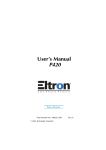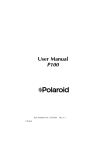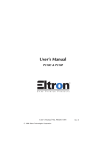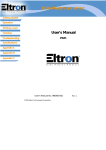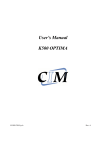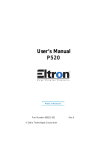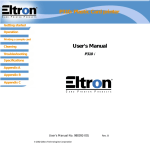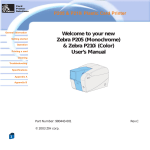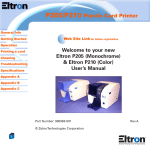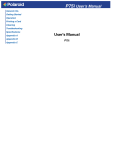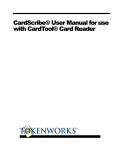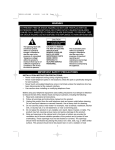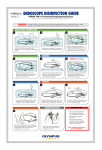Download P75 User Manual
Transcript
User Manual P75 © 2000 POLAROID FOREWORD This manual contains installation and operation information for the Polaroid 75 Series card printers manufactured by Polaroid Corporation. RETURN MATERIALS AUTHORIZATION Before returning any equipment (camera or printer) to Polaroid Corporation for in-warranty or outof-warranty repair, contact Repair Administration for a Return Materials Authorization (RMA) number. Repack the equipment in the original packing material and mark the RMA number clearly on the outside. Ship the equipment, freight prepaid, to the address given to you by Repair Administration. COPYRIGHT NOTICE This document contains information proprietary to Polaroid Corporation. This document and the information contained within is copyrighted by Polaroid Corporation and may not be duplicated in full or in part by any person without written approval from Polaroid. While every effort has been made to keep the information contained within current and accurate as of the date of publication, no guarantee is given or implied that the document is error-free or that it is accurate with regard to any specification. Polaroid reserves the right to make changes, for the purpose of product improvement, at any time. TRADEMARKS Polaroid 75 is a pending service mark. Polaroid is a registred trademark of Polaroid Corporation, Cambridge, MA. All other trademarks or registered trademarks are marks of their respective holders. iii WARRANTY INFORMATION WE NEED TO HEAR FROM YOU! To establish Your Warranty Period And Provide Access To Technical Support, Send Us your Warranty Registration Card Today! Polaroid warrants the mechanism, control electronics and power supply, under normal use and service, to be free from defects in material and workmanship for a period of twelve (12) months from the date of purchase by the end user. Polaroid warrants the print head, under normal use and service, to be free from defects in material and workmanship for a period of twelve (12) months from the date of purchase by the end user. Proof of purchase is required. If proof of purchase cannot be established, shipment date to the original buyer (dealer or distributor) will be used to establish the warranty period. Failure to exercise caution to protect the equipment from electrostatic discharge damage, adverse temperature and humidity conditions or physical abuse, including, but not limited to, improper packaging, shipping, service or repairs performed by personnel not authorized by Polaroid may void the warranty. Failure to use only Polaroid approved media may void the warranty. Polaroid will, at its option, repair or replace the equipment or any parts which are determined to be defective within this warranty period, and which are returned to Polaroid. The warranty set forth above is exclusive and no other warranty, whether written or oral, is expressed or implied. Polaroid specifically disclaims the implied warranties of merchantability and fitness for a particular purpose. DECLARATIONS OF CONFORMITY European Council Directive Compliance to Standards 89/336/EEC modified by 92/31/EEC and 93/63/EEC EMC Directive EN 55022-B RF Emissions control EMC Directive EN 500082-1, 1992 Immunity to Electromagnetic Disturbances 73/23/EEC modified by 93/68/EEC Low voltage Directive EN 60950 Product Safety Model: P75 conforms to the following specification: FCC Part 15, Subpart A, Section 15.107(a) and Section 15.109(a) Class A digital device Supplemental Information: This device complies with Part 15 of the FCC Rules. Operation is subject to the following Two Conditions: (1) This device may not cause harmful interference , and (2) this device must accept any interference received, including interference that may cause undesired operation. Note: This equipment has been tested and found to comply with the limits for a class A digital device, pursuant to Part 15 of the FCC Rules. These limits are designed to provide reasonable protection against harmfull interference when the equipment is operated in a commercial environment. This equipment generates, uses, and can radiate radio frequency energy and, if not installed and used in accordance with the instruction manual, may cause harmfull interference to radio communications. Operation of this equipment in a residential area is likely to cause harmfull interference in which case the user will be required to correct the interference at his own expense. INDUSTRY CANADA NOTICE This device complies with Industry Canada ICS-003 class A requirements. Cet équipement est conforme à l'ICS-003 classe A de la Norme Industrielle Canadienne. iv INTRODUCTION Thank you for choosing the P75 Plastic Card Printer. These printers produce cards ideal for personalised identification, access control, visitor, membership, promotion and luggage card, badges and tags. This manual guides you to an efficient start up and operation of your new Card Printer. P75 PRINTER MODELS The Polaroid Product Number tells a story: Here is a quick review of the Polaroid Card Printer Series numbering and lettering system to help you. The P75 Plastic Card Printer employs Dye Sublimation and Resin Thermal Transfer technologies. Model numbers include identifiers that specify options are shown using the following lettering conventions: P75 Serial Number M : Magnetic Encoding E : Smart Card } Optional C : Color This information can be found on the printer serial number panel and is also shown on the test card. v ICONS Throughout this manual, different icons highlight important information, as follows: Important general information Mechanical hazard, such as one associated with moving parts, capable of resulting in equipment damage or personal injury. Electrical hazard, such as an exposed voltage point, capable of causing electrical shock and personal injury. An area where electrostatic discharge (ESD) can cause component damage. Use a grounding wrist band. Elevated temperature hazard, capable of producing a burn. Keep Card Printer clean by minimizing cover open time. vi Table of Contents 1. GETTING STARTED ........................................................................ UNPACKING YOUR CARD PRINTER ...................................... INDICATORS AND CONTROLS ................................................ PRINTER INSTALLATION .......................................................... 1.1 1.1 1.3 1.4 2. OPERATION .............................................................................. P75 PRINTER FEATURES .......................................................... LOADING RIBBONS .................................................................. LOADING CARDS ...................................................................... INSTALL CARD CLEANING CARTRIDGE ................................ FEEDING ONE CARD AT A TIME ............................................ REMOVING CARD CARTRIDGE .............................................. PRINTING A TEST CARD .......................................................... PRINTER MENU INFORMATION .............................................. 2.1 2.1 2.2 2.4 2.5 2.7 2.7 2.8 2.9 3. STARTING TO PRINT CARDS .................................................... 3.1 4. CLEANING ................................................................................ CLEANING SYSTEM .................................................................. CLEANING THE PRINT HEAD .................................................. CARD CLEANING CARTRIDGE ................................................ 4.1 4.2 4.3 4.4 5. TROUBLESHOOTING ................................................................ 5.1 6. TECHNICAL SPECIFICATIONS .................................................. 6.1 APPENDIX A - MAGNETIC CARD STRIPE ENCODER .................... A.1 APPENDIX B - SMART CARD CONTACT STATION ...................... B.1 INTRODUCTION ........................................................................ B.1 APPENDIX C - ACCESSORIES & SUPPLIES .................................. RIBBONS .................................................................................... CARDS ........................................................................................ ACCESSORIES............................................................................ C.1 C.1 C.2 C.3 vii 1 GETTING STARTED UNPACKING YOUR CARD PRINTER Your P75 printer ships in a carton and protective anti-static bag. Keep all packing material in case you need to move or re-ship the printer. While unpacking, inspect the carton to ensure that no damage occured during shipping. Please ensure that you have a clean and nearly dust free environment for proper operation and storage of the printer. 1.1 In addition to user documentation, make sure the following items are included with your P75 printer: CARD CARTRIDGE CARD OUTPUT HOPPER SWABS & SATURATED CLEANING CARDS POWER CABLE INTERFACE CABLE PRINTER DRIVER DISK CLEANING CARTRIDGE If any items are missing, please contact your dealer. To reorder, please refer to Appendix C of this manual. 1.2 INDICATORS AND CONTROLS Your P75 printer has an LCD Display, two LED's and two panel buttons. LCD Display Power LED Alert LED M e n Button [Next] u Clear Button [Select] LCD Display : The 16 character LCD Display is used for : - Showing the printer's current status - Providing operator and service messages (Chapter 5) LED's : The two LED's are used for : - Green: Power LED - Amber: Alert LED (with beeper) This Alert LED is on when an error condition exists. The Beeper will sound three alert "Beeps" and the LCD Display will show the associated error message. PANEL BUTTONS: The Menu Button (left) is a push button used for: - bringing printer into Menu Mode when pressed with the printer showing READY on the LCD Display. - using in Menu Mode to scroll through Menu Options. The Clear Button (right) is a push button used for: - clearing an error status (when LCD Display shows an error report and Alert LED is on). - invoking automatic retry of the operation which gave the error. NOTE: the buttons beep when pressed 1.3 PRINTER INSTALLATION The following will guide you through the installation of your P75 printer. CAUTION : Limit AC power supplied to the P75 Printer to 110 - 230 V AC, 60 - 50 Hz for an associated 800 mA - 400 mA. Limit excess current draw to 16 amps or less, using an associated circuit breaker or other such device. Never operate the printer in a location where operator, computer, or printer can get wet. Personal injury could result. The printer must be connected to an earthed electrical power supply and properly protected against electrical surges and grounding faults. 1. Place the printer in a location that allows easy access to all sides. The printer should never be operated while resting on its side or upside down. 2. Place the printer’s power switch in the OFF (0) position. 3. Insert the power cable to the printer power socket and attach to grounded electrical socket of the proper voltage and type. 4. Attach interface cable to printer and computer and then secure. 5. Switch power on. CAUTION: Intermittent or unpredictable operation may occur from unsecured connectors. If damaged, the power cable must be replaced by an exact equivalent. 1.4 2 OPERATION P75 PRINTER FEATURES The following shows the features found on your P75 Printer: 1 9 8 2 3 7 5 A 6 4 B PLEASE NOTE : Any blue items inside the printer can be operated by the user. STANDARD FEATURES 1. Print Head 2. Print Head Unlock lever 3. Card Output Hopper 4. LCD Display 5. Panel Button LED's 6. Card Cleaning Cartridge 7. Card Cartridge OPTIONAL FEATURES A. Magnetic Encoder Station B. Smart Card Contact Station 2.1 LOADING RIBBONS The P75 Printer requires approved ribbons (See Appendix C). The Resin Thermal Transfer and Dye Sublimation ribbons are specifically designed for your P75 Printer. For optimum performance and printer life (Print Head), always use approved ribbons. DO NOT TOUCH the print head or the electronic components on the print head carriage. Discharges of electrostatic energy that accumulates on the surface of the human body or other surfaces can damage the print head and other electronic components used in this device. 1. Remove ribbon from packaging. 2. With printer power on and READY status, open cover and press down on the Print Head Unlock Lever to open the print head carriage. The print head carriage will pop open. Continued on next page ...... 2.2 SUPPLY SPINDLE 3. Load ribbon onto the supply spindle (under print head carriage) and empty core (with tape attached) onto the takeup spindle. Make sure the ribbon comes off the top of the supply spindle and feeds to the top of the take-up spindle. TAKE UP SPINDLE `CLICK' 4. Push down on the Print Head Lock Lever until an audible 'click' signals the locked-down position. 5. Close Cover. Please note that the ribbon automatically synchronises whenever the print head lock down occurs. 2.3 LOADING CARDS To help you load, print, and collect cards, the P75 has the following items: A - CARD CARTRIDGE For loading cards 1. Install Card Cartridge by hooking onto printer as shown and clicking down. 'CLICK' 2. Install cards into Cartridge.* DO NOT bend cards or touch print surfaces as this can reduce print quality. The surface of the cards must remain clean and dust free. Always store cards in an enclosed container. Ideally, use cards as soon as possible. If cards stick together, carefully shuffle them. 3. Close Cartridge. * See Chapter 6, Technical Specifications, for card requirements and capacities. 2.4 B - INSTALL CLEANING CARTRIDGE This item is used to clean the cards entering the printer. 1. Remove Card Cleaning Cartridge from packaging. 2. Open Printer cover and locate Cleaning Cartridge place. Remove the yellow adhesive. 3. Make sure the arrow on top of the assembly is facing toward the rear of the printer. Hook assembly into slot on printer and rotate down. Ensure the assembly locks in place. 2.5 C - CARD THICKNESS CONTROL LEVER This item is operated by the user to prevent more than one card feeding into the printer at the same time and causing a jam. Open Cover, and adjust lever to correct position. Repeat for different card thickness. (Factory setting is for 30mil (0.762 mm) card thickness. See diagram below : Card thickness: A - 60mil (1.524mm) to 50mil (1.27mm) B - 40mil (1.016mm) C - 30mil (0.762mm) D - 20mil (0.508mm) E* - Less than 20mil (0.508mm) * Start at lowest position and move lever up to match card thickness. For other card thickness, start lever at lowest position and move up until cards feed. D - CARD OUTPUT HOPPER For collecting printed cards. Install Card Output Hopper onto printer by hooking over bottom edge of card exit aperture. 2.6 FEEDING ONE A Manual Feed Slot is available on the side of the CARD AT A TIME Card Input Hopper for feeding single cards. Cleaning Cards are fed manually through this slot. The Card Cartridge must be empty for manual card feeding to work properly. For one-at-a-time printing, feed cards through slot on side of Hopper. Do not feed more than one card at a time. REMOVING CARD Remove the Card Cartridge prior to CARTRIDGE packaging the printer for shipment. To remove, pull hook back, and lift hopper out. HOOK 2.7 PRINTING A TEST CARD With ribbon and cards loaded, your P75 printer is ready to print. To check the operation of the printer you should print a test card. 1. Place the printer's power switch in the OFF (0) position. 2. While pressing the right panel button, switch printer on. LCD screen will show 'SELF TEST' 3. Release button once 'SELF TEST' is displayed on LCD screen. 4. A test card will print after a few seconds. LCD display will show printing status. This is an example of the test card. 2.8 PRINTER MENU INFORMATION Menu Button [NEXT] The printer is equipped with a LCD Display which gives access to different menus. Menu key moves from READY Status into the Main Menu by pressing the Menu Button : Clear Button [SELECT] The top line display shows menu information. The second line of display clarifies the function of the two [NEXT] and [SELECT] press buttons relative to the current menu item. 2.9 Printer Model Number Printer Firmware Version PRINTER INFO Number of impressions GO TO MAIN MENU CLEAN PRINT HEAD To clean the Thermal Print Head and card transport system CLEANING CLEAN MAG.HEAD To clean the magnetic Encoder Head GO TO MAIN MENU READY TEST PATERN To print a printer test card SELF TEST PRINT PARAMETERS To print a test card showing the operating parameter settings of the printers MAG - PARAMETERS To print a test card showing the operating parameter settings of magnetic encoder. GO TO MAIN MENU Ribbon type To show the type of ribbon installed. It may not match the ribbon physically installed until the installed ribbon has been selected through the driver PRINTER DEFAULTS Offset X: aa-Y:bb To show the X print location offset value in pixels (aa) To show the Y print location offset value in pixels (bb) Mag. Option: cccc To show the setting of the magnetic encoder as (cccc), which can be: - HICO (high coercivity) - LOCO (low coercivity) - NONE (no encoder present) Color Parameters To show the intensity values of Yellow (Y), Magenta (M) and Cyan (C) panels and contrast value of Black Resin (K) Panel. GO TO MAIN MENU 2.10 3 STARTING TO PRINT CARDS Printing with the P75 Printer requires the Windows printer driver, the Windows ID Card Maker application software package or printer command level programming through the printer interface. The P75 Card Printer can be used with any Windows 95/98 and Windows NT 4.0 software application program, using the drivers provided with the printer. This section contains information on the printing of a sample card in color (using the 5-Panel color ribbon YMCKO) and the Windows printer driver. BEFORE installing updated printer driver versions, always delete the existing printer driver version from your computer. 3.1 TO INSTALL THE P75 PRINTER DRIVER IN WINDOWS 95/98, USE THE FOLLOWING STEPS: IMPORTANT NOTE - ENSURE THAT YOUR PC PRINTER PORT IS SET TO STANDARD MODE AND ALSO ENSURE THAT YOU HAVE DELETED ANY PREVIOUS VERSIONS OF THIS PRINTER DRIVER. IF YOU HAVE ANY DOUBTS PLEASE CONTACT YOUR IT DEPARTMENT. This installation uses floppy drive 'A' as the installation drive with the printer used as stand alone. 1. Start your computer and then Windows. 2. Insert your 'POLAROID Software' diskette into the drive 'A'. 3. Under Windows click the Start button, select Settings, then Printers. 4. Double click on the Add Printer icon and also Next. 5. Ensure Local Printer is selected and click on Next. 6. Click on Have Disk and then type in 'A:\win95' and click OK. 7. P75 CARD PRINTER should be displayed after which click on Next. 8. Choose LPT1 : ECP Printer Port, click on Next, select Yes to set as Default Printer and click on Finish to install. The Printer Wizard will copy the necessary files to the PC for you and the P75 printer driver installation will be completed. TO INSTALL THE P75 PRINTER DRIVER IN WINDOWS NT4.0: Ensure that you have administrative privileges to perform this installation or contact your IT department. Set printer as Not Shared for stand alone use. Use the steps provided for Windows 95/98 installation with the exception of step 6. A:\nt40' instead and click OK. where you must type in 'A 3.2 Once the printer driver has been successfully installed, you will need to configure it for your printer. This driver provides control of several printer features when printing from Windows applications. These features are accessed through the P75 Plastic Card Printer Properties. To access these properties select the P75 Card Printer icon in Printers. Then click File Menu and select Properties. The P75 Printer screen appears. Change the options as follows: 1. On the Printer Tab configure the magnetic encoder feature. If your printer is equipped with a Magnetic Encoder option, select With Magnetic Encoder option. 2. On the Card Tab select card orientation: Landscape or Portrait - Select 'Landscape'. 3. On the Ribbon Tab, select the Ribbon Type. Select YMCKO for the standard 5-panel ribbon. 4. In the same tab, go to Black Panel area and select Text Only. This option allows the text printing using the Black Resin Panel from the Color Ribbon. 5. Close the POLAROID 75 Printer Properties screen. Now that you have loaded media and set up the printer driver, the P75 Printer is ready to print. EXAMPLE: FOLLOW THESE STEPS TO PRINT YOUR FIRST CARD: 1. Go to the microsoft Word Software. 2. If the printer was not selected as the default printer, go to the file menu and select Print and choose Polaroid 75 Card Printer in the printer names list. Then Close the print dialog box. 3. Come back to file menu and choose Page Setup. 4. Select paper Size tab and in Paper Size choose Card. Then select the orientation: "landscape". 5. Go to Margins Tab, put the top, Bottom, left- and right margins with O values. 6. Press OK to close Page Setup Window. 7. The card appears on the screen. 3.3 8. Design a card with both black and colored text and colored pictures,i.e.: Symbols in color Text in Red Logo in Black and White 9. Text in Black Once you are ready to print, go to File and point Print 10. The printer will feed in a card and start printing ( the data download time will vary depending on the complexity of the card design and the processing speed of your computer). 11. Once the printing job is achieved the card is ejected from the printer. 3.4 4 CLEANING PROTECT YOUR FACTORY WARRANTY ! The recommended maintenance procedures must be performed to maintain your factory warranty. Other than the recommended cleaning procedures described in this manual, allow only Polaroid authorised technicians to service the P75 Printer. NEVER loosen, tighten, adjust, or bend, etc. a part or cable inside the printer. NEVER use a high pressure air compressor to remove particles in the printer. 4.1 CLEANING SYSTEM Your P75 Printer includes a simple cleaning system using the Pre-saturated Cleaning Cards provided. The regular use of these cards will clean and maintain important parts of your printer: including the Print Head, and Transport Rollers. CLEAN PRINTER WHEN TO CLEAN When LCD screen reports message. HOW TO CLEAN 1. Leave power on. Open Cover and release Print Head Bracket to remove ribbon. Close Print Head. Close Cover. Remove cards from Card Cartridge. 2. Insert one Pre-saturated Cleaning Card (provided) through slot on the side of the Card Cartridge. 3. Press the Clear Panel Button (right) for a few seconds. The card will feed into printer and carry out the cleaning process. Repeat the process with a new Cleaning Card if necessary. Notte: For cleaning prior to the WHEN TO CLEAN signal, press the Right Panel Button for 3 seconds to start the cleaning process (Repeat first steps 1 and 2 above). Although the CLEAN PRINTER message is displayed until the cleaning process has been performed, the printer will continue to operate. 4.2 CLEANING THE PRINT HEAD A cleaning using the Cleaning Cards usually suffices. However, a separate Print Head cleaning using swabs can remove more stubborn deposits when print anomalies persist. To avoid deposits, only use foam-tipped swabs. 1. Raise Print Head and remove the Ribbon. 2. Clean Print Head by moving alcoholmoistened swab tip side-to-side across Print Head elements. Only use moderate force. (To reorder swabs see Appendix C). Never use a sharp object to scrape deposits from the print head. Permanent damage will result. 4.3 CARD CLEANING CARTRIDGE CLEAN PRINTER Your P75 Printer also has a Card Cleaning Cartridge. This item cleans the cards entering the printer. To ensure print quality, the cleaning roller requires periodic replacements. WHEN TO MAINTAIN When LCD screen reports message. HOW TO MAINTAIN 1. Open Cover and locate Cleaning Cartridge. 2. Gently remove Cleaning Cartridge by rotating up and away from printer. Continued on next page .... 4.4 3. Remove Cleaning Roller from Cartridge and discard. 4. Install new Cleaning Roller into Cartridge*. To avoid contamination, always hold the Cleaning Roller assembly by the ends. SLOT 5. Carefully peel off wrapper from new Cleaning Roller while in Cartridge. 6. To replace Cartridge into printer: Make sure the arrow on top of the assembly is facing toward the rear of the printer. Hook assembly into slot on printer and rotate down. Ensure the assembly locks in place. DO NOT touch the roller surface that contacts the cards. 7. Close Cover * See Appendix C for replacement Cleaning Rollers. Although the CLEAN PRINTER message is displayed until maintenance has been performed, the printer will continue to operate. 4.5 5 TROUBLESHOOTING This section offers solutions to potential problems you may experience with your P75 printer. The table below lists the screen messages that will be displayed on the printer's LCD, both during normal operation and to alert operator of any error conditions. There is also some additional information dealing with quality issues concerning printing onto cards. SCREEN MESSAGE MEANING INITIALISING The printer is performing an internal test before use READY ACTION Wait for the ready message Ready for use PRINTING Card printing in progress Please wait WAIT TEMPERATURE The printer is warming up Wait for READY message ON LINE Waiting for host data Send card data SELF TEST Self test card printing Wait for test card DOWNLOADING DATA The card data is being transmitted Wait for card printing to start PRINTING YELLOW 5.1 The yellow panel is printing SCREEN MESSAGE PRINTING MAGENTA MEANING PRINTING CYAN The cyan panel is printing PRINTING BLACK The black panel is printing PRINTING VARNISH PRINT HOLOGRAM MOVING CARD CLEAN PRINTER CLEANING ACTION The magenta panel is printing The overlay is printing A hologram overlay is printing The card is being transported The printer is prompting operator maintenance Carry out the cleaning procedure as detailed in section 4 of this manual The printer is performing an internal cleaning routine REMOVE RIBBON The ribbon has not been removed whilst the cleaning operation is in progress OUT OF RIBBON The printer ribbon has run out MECHANICAL ERROR The printer has an error moving the card internally Remove the jammed card. Ensure that the card is not out of specification The card feeder is empty Add more cards or adjust the card feeder to accept the cards Lock the print head in its lower position OUT OF CARD HEAD OPEN COMMAND ERROR PARAMETERS ERROR The print head is not locked into position Remove ribbon Replace printer ribbon The data being sent from the Check that the data is suitable for printing. Try rehost is not recognised printing a card from known 'good' data The features of the card are not recognised Check the Windows driver options and printer type 5.2 SCREEN MESSAGE ENCODING ERROR MAGNETIC ERROR BLANK TRACK FLASH ERROR NO ACCESS MEANING ACTION Data cannot be written or Check that the cards are read from the card's magnetic loaded with the magnetic stripe stripe in the correct orientation. Check whether high or low coercivity cards have been specified. Check that the data conforms to ISO specifications. See Appendix A of this manual for further information. The printer cannot detect a magnetic stripe on the card. Check the card orientation Contact your dealer for technical support. Ribbon Errors: Check that the print ribbon has not 'run out'. Lock and then unlock the print head assembly; this resynchronises the ribbon automatically. When using a color ribbon, it should advance automatically so that the leading edge of the Yellow panel is beneath the print head. Ensure that the correct ribbon type has been specified in the Windows driver. Card Feed & Mechanical Errors: Ensure that the card thickness adjustment has been set-up correctly to allow one card to feed. Magnetic Encoding Errors: Check that the cards are inserted correctly in the printer. Ensure that the cards are low or high coercivity as required, and are set-up correctly in the printer driver. Cleaning Alert: The printer has counted the number of cards printed and has automatically flagged that a cleaning routine needs to be carried out. (See Chapter 4). 5.2 QUALITY ISSUES Missing print or white lines: Ensure that the ribbon is neatly winding onto the take-up core and that no creases are visible on the used ribbon. If there is a fine white line in the same place on the card, this indicates possible print head damage. Poor Print Quality: Print a Self-Test card, and check that the printer is clean and dust free. Check that the correct type of ribbon is being used and is specified correctly in the Windows driver. Ensure that the cards are clean and are not covered by loose plastic particles. Do not try reprinting previously printed cards as the ink will not bond correctly to the card Missing areas of print: Ensure that the cards are flat and free from any surface depressions. The cards and printer must be clean and not contaminated by grease, dust or other particles. 5.3 6 TECHNICAL SPECIFICATIONS General • High speed printing, over 140 cards/hour edge to edge in full color (YMCKO) throughput • Small footprint • Windows Drivers for 95/98 and NT 4.0 (option) • One year printer warranty • One year print head warranty Colour Printing • Color dye sublimation or monochrome thermal transfer printing • 25 seconds per card edge to edge in full color (YMCKO) • 300 dpi (11.8 dots/mm) print resolution • Edge to edge printing standard 6.1 Fonts • Resident: Arial Normal 100, Arial Bold 100 • True Type fonts available via Windows Driver Cards* • Types PVC, Composite • Card width/length: ISO CR-80 - ISO 7810, 2.125” (54mm) by 3.375” (86mm) • Option: Magnetic Stripe - ISO 7811 • Option: Smart Card - ISO 7816-2 • Card thickness: 0.25mm to 1.524mm • Card Cartridge capacity: Up to 210 cards 0.25mm), up to 75 cards (0.15mm) CARD DIMENSIONS ISO STANDARD DIMENSIONS FOR PLAIN CARD ISO STANDARD DIMENSIONS FOR MAGNETIC STRIPE CARD CHIP POSITION FOR SMART CARD ISO STANDARD AFNOR STANDARD * Use Polaroid approved media only. 6.2 Ribbons* Overlay Varnish Interfaces Mechanical Electrical Environmental • Monochrome: 1500 cards/roll • Monochrome colors: black, red, blue, green, silver, gold, white, Scratch-off gray • K-resin + O: 800 cards/roll • K-dye + O: 800 cards/roll • YMCKO: 200 cards/roll • YMCKO: 350 cards/roll • Thermal transfer • 4 microns thick • Clear and holographic options: - Clear - Genuine/Secure Hologram - Custom Hologram • Parallel Standard (cable included) • RS-232C Serial (option) • Width: 329 mm† • Depth: 219 mm† • Height: 232 mm† • Weight: 6.3 kg • 110 ~ 230 Volts AC, 60 ~ 50 Hz • FCC Class A, CE, UL, and CUL approved • • • • • Operating Temperature: 60 to 86°F (15 to 30°C) Operating Humidity: 20 to 65% non condensing Storage Temperature: -23 to 158°F (-5 to 70°C) Storage Humidity: 20 to 70% non condensing Ventilation: Free air * Thermal transfer (Resin) ribbons offer more durability than dye sublimation, with greater resistance to scratches and UV-induced fading. Dye Sublimation printing requires dye sublimation ribbons, with either black or cyan, magenta, and yellow (plus black resin) panels. † Measured without card feeder and card hopper. 6.3 Options • • • • • • • RS-232C serial port Smart Card Contact Station (0.76mm cards only) Magnetic Encoder (0.76mm cards only) Extended Warranty program Hot Swap Warranty program Cleaning supplies Service Manual Use only Polaroid-approved card and ribbon media. Using non-approved card or ribbon media can void your warranty. Refer to the Accessories section for more information about Card and Ribbon Media available from Polaroid. 6.4 APPENDIX A - MAGNETIC CARD STRIPE ENCODER Operation and maintenance requirements for the P75 Printer with the optional magnetic card stripe encoder. (See Chapter 2 for location). The magnetic encoder can be set for either high or low coercivity. The magnetic encoder is a factory installed item with the read/write head positioned below the card path, available with HICO encoding or LOCO encoding. STRIPE DOWN When loading cards into the Card Cartridge, please ensure that the magnetic stripe is facing towards the printer and closest to the rear. Also available are Printer models with the Magnetic Read/Write head positioned above the card path, with HICO encoding or LOCO encoding. STRIPE UP When loading cards, please ensure that the magnetic stripe is facing away from the printer and closest to the rear. Approved HICO & LOCO PVC cards are available. (See Appendix C). ONLY USE cards that comply with ISO 7810 & 7811 standards for magnetic stripe cards. The magnetic stripe must be flush to the surface of the card to work properly. Never use tapedon magnetic stripes. A.1 The read/write head requires periodic cleaning to maintain error-free encoding. CLEAN PRINTER WHEN TO CLEAN When LCD screen reports message. HOW TO CLEAN 1. Leave power on. Open Cover and release Print Head Bracket to remove ribbon. Close Print Head. Close Cover. Remove cards from Card Cartridge. 2. Insert one Pre-saturated Cleaning Card (provided) through slot on the side of the Card Cartridge. 3. Press the Clear Panel Button (right ) for a few seconds. The card will feed into printer and carry out the cleaning process. Repeat the process with a new Cleaning Card if necessary. Notte: For cleaning prior to the WHEN TO CLEAN signal, press the Right Panel Button for 3 seconds to start the cleaning process. (repeat first steps 1 and 2 above) Although the CLEAN PRINTER message is displayed until maintenance has been performed, the printer will continue to operate. ISO STANDARD ENCODING Track # Field Separator Track density Valid Characters 1 ^ 210BPI* 2 = 75BPI* 3 = 210BPI* Alphanumeric (ASCII 20∼95†) Numeric (ASCII 48∼62) Numeric (ASCII 48∼62) # of characters 79‡ 40‡ 107‡ * Bit per inch † Except the '?' character ‡ Including Start, Stop and LRC characters. Also note that these 3 characters are automatically managed by the magnetic encoder according to the ISO Standard Norms. NOTE: Refer to the Card Printer Programmer's Manual for complete programming information. A.2 APPENDIX B - SMART CARD CONTACT STATION This section contains information on the additional operations of the P75 Printers with Smart Card Contact Stations. (See Chapter 2 for location.) INTRODUCTION B.1 Smart Cards can have a built-in microcomputer and a battery. Card Memory can store fingerprints, voice recognition patterns, medical records and other such data. The P75 may be equipped with an optional contact station for programming Smart Cards (ISO 7816). This printer model responds to commands that position the cards at the contact station, where the printer connects to the contacts on the Smart Cards. All other printer operations remain the same as the standard P75 model. MEDIA LOADING ORIENTATION Position the cards with the Smart Card Chip at the top of the card and facing away from the printer. SMART CARD CONTACT STATION INTERFACE When a command to the parallel printer interface sends a card to the Smart Card Contact Station, the printer connects the Smart Card Contact Station to the female DB-9 connector on the rear of the printer. An attached external Smart Card Programmer can be used to program Smart Card chips. DO NOT position printing over the Smart Card Chip. DB - 9 PINS SMART CARD CONTACT POINTS DB - 9 PINS SMART CARD CONTACT POINTS 1 CI (Vcc) 6 C6 (Vpp) 2 C2 (Reset) 7 C7 (I/O) 8 C8 (RFU) 9 (GND when chip is at station) 3 C3 (Clock) 4 C4 (RFU) 5 C5 (GND) Refer to the Card Printer Programmer's Manual for complete programming information. B.2 APPENDIX C - ACCESSORIES & SUPPLIES Please contact your Polaroid authorised dealer to place an order for accessories and supplies RIBBONS The following ribbons may be used in the P75 Printer: Monochrome Resin Ribbon Description (sold by the roll) Black (1500 images) Red (1000 images) Green (1000 images) Blue (1000 images) White (1500 images) Gold (1500 images) Silver (1500 images) Scratch-off Grey (1000 images) Color Ribbon Description (sold by the roll) 5-panel 5-panel 2-panel 2-panel 2-panel 2-panel (YMCKO) - (350 images) (YMCKO) - (200 images) (K dye + O) - (500 images) (K resin + O) - (600 images) (K dye + O) - (800 images) (K resin + O) - (800 images) 2-panel (K resin + O) - (800 cards) Note : M = Magenta, C = Cyan B = Black , O = Overlay Monochrome resin ribbons are suitable for printing text, graphics and bar codes, but not images. K dye + O ribbons are recommended for printing monochrome images. C.1 CARDS The following plain white plastic cards are available for use in the P75 printers: Card Description Cards with no magnetic stripe Cards with low coercivity magnetic stripe Cards with high coercivity magnetic stripe Self-adhesive cards to fix onto proximity cards Many other card types are also available; ask your dealer for more information. C.2 ACCESSORIES Accessories available for P75 Printers are listed below: Accessories Description Printer cable, parallel, DB25 male to female Additional Card Cartridge P75 User's Manual Premier Cleaning Kit: cards (50) and swabs (25) Replacement Print Head Kit Adhesive Cleaning Roller Kit (5) Complete Cleaning Cartridge C.3












































